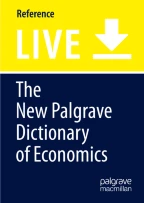
Since antiquity, a distinction between monopoly and competitive market structures has been recognized. Aristotle (Book I, 5) characterized ‘monopoly’ [μóνos (alone), \( \pi \omega \lambda \upepsilon \iota \overset \) (sell)] as a situation in which a single trader engrossed the entire supply. He recounted how one such iron ore monopolist had been expelled from Syracuse by its ruler, Dionysius. Adam Smith (1776, Book I, chapter VI) advanced somewhat beyond the Aristotelean schema, contrasting the price under monopoly (‘the highest which can be got’) to that of free competition (‘the lowest which the sellers can commonly afford to take, and at the same time continue their business’). The most important single step toward a modern theory of how market structure matters was taken by Cournot (1838). He perceived correctly that a monopolist confronts the downward-sloping demand function for its product, and he derived the mathematical conditions (essentially, equality of marginal revenue with marginal cost) by which the monopolist maximized its profits. He then showed how market prices fell with increasing numbers of competitors, converging in the many-seller case toward a zero-profit condition. Thus Cournot provided among other things the first theory of oligopoly, that is, of markets with only a few sellers.
This chapter was originally published in The New Palgrave: A Dictionary of Economics, 1st edition, 1987. Edited by John Eatwell, Murray Milgate and Peter Newman
This is a preview of subscription content, log in via an institution to check access.